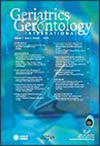Relationship between decreased activities of daily living, decreased physical strength and future weight loss in community-dwelling older adults
Abstract
Aim
Weight loss is among the diagnostic criteria for frailty and is associated with increased mortality among older people. This study aimed to identify factors associated with future weight loss among community-dwelling older people.
Methods
A multidimensional questionnaire-based prospective cohort study was carried out. The questionnaire included the Kihon Checklist, instrumental activities of daily living (IADL) scale, Activity Scale for the Elderly, Fall Risk Index-21 and Dietary Variety Score. The associations among the scores of the scales and the 3-year weight change from study entry were assessed. The participants were categorized into the non-weight loss group, <4.5-kg weight loss group and >4.5-kg weight loss group.
Results
In total, 982 participants completed the follow up. Their mean age was 73.4 ± 5.1 years, and 545 (55.5%) participants were women. Among the IADL questionnaire subitems, depositing and withdrawing money from the bank, walking, interacting with people, taking medication, and cooking were associated with 3-year weight loss. Furthermore, cooking was strongly associated with weight loss. However, there was no association between eating frequency and weight loss. Finally, low IADL and physical function scores were associated with a doubled risk of future weight loss.
Conclusions
An association was found between 3-year weight loss and physical fitness and IADL, such as walking, among community-dwelling older people. Future weight loss in older people can be caused by a decline in IADL and physical fitness before a decline in dietary intake. Furthermore, maintaining IADL and physical fitness can prevent future weight loss and frailty. Geriatr Gerontol Int 2025; 25: 418–424.


 求助内容:
求助内容: 应助结果提醒方式:
应助结果提醒方式:


